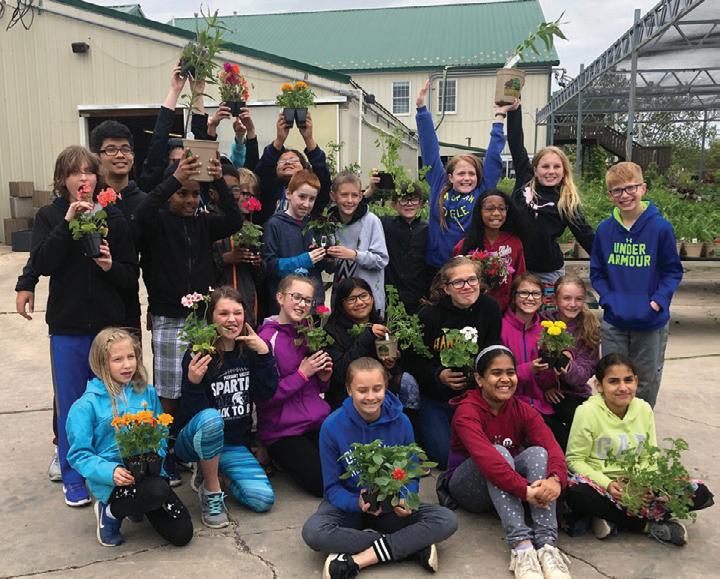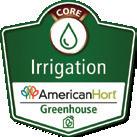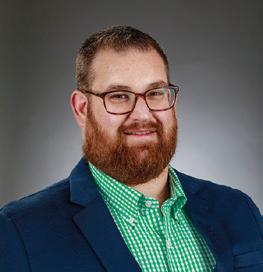








How independent garden centers are creating opportunities to boost revenue and loyalty.
Independent garden centers are finding that offering alternative products and services keep customers visiting year-round, not just during peak seasons. Online and big-box competition is intensifying, and shoppers expect more than a simple checkout transaction alone. Customers want services, experiences, and a sense of community.
Wallace’s Garden Center in Bettendorf, Iowa, and Koetsier’s Greenhouse in Grand Rapids, Michigan, have leaned into creative income streams to smooth out seasonal slowdowns, reach new audiences, and deepen customer relationships. Examples of their offerings show that sometimes opportunities knock and sometimes they are intentional.
Christmas tree setup has become a profitable off-season niche at Wallace’s Garden Center.
“If they have an artificial tree that they bought from us, they can pay us every year to come and put it up,” says Kate Terrell, President of Wallace’s Garden Center.
Her team hauls the tree from the basement, assembles, fluffs and plugs it in—sometimes returning in January to take it down and store it. The service, typically $80–$100 plus delivery, has struck a chord with older customers and families whose schedules prevent early decorating.

“That tree set up is a pretty good little business for us,” Terrell says, especially during the lull before holiday shopping peaks.
Melinda Koetsier, Events and Marketing Director of Koetsier’s Greenhouse, noticed that including a few couches into their retail space brought members of the community to their store to relax and connect with staff

and each other. They added some crafting sessions and eventually brought in long communal tables to host planting and craft workshops. The space is known as “The Table,” and events there have drawn in entirely new customers.
“These classes have brought in people that have never been here before,” Koetsier notes. Projects range from decoupage pumpkins to cider-and-succulent nights with local beverage partners. Koetsier gives participants swag bags with coupons to encourage return visits and offers free coffee through a partnership with a café employing people with intellectual disabilities.
The goal, she says, is to make the greenhouse “a place where people feel comfortable and welcome” while also generating ticket sales and add-on purchases.
Wallace’s has also found a new revenue stream in group activities. For school groups, they offer fee-based tours with scavenger hunts and planting activities priced from $5–$10 per child. Private group classes, such as a porch pot-making


class, for example, can garner upwards of $65 per person. Terrell credits a dedicated community-outreach team member with turning one-off requests into a structured program.
“Now when someone wants to do a field trip or a group activity, it’s, ‘Here’s what we offer, here’s the price,’” she says.
Both Terrell and Koetsier have met challenges and learned lessons from their extra-revenue experiences. For instance, Terrell said that insurance, liability and additional requests can complicate in-home services. She would advise others to be clear about the limits of staff services on site. She also has had repeated requests from clients for Wallace’s staff to decorate as well as set up their tree, but, as Terrell realized, “my merchandisers are too valuable to have off the retail floor at that time of year.”
For Koetsier, the challenge is finding the right mix of classes. Some classes flop while others sell out, but they try to keep costs low and schedules events at different times to reach retirees, families or working adults. Her advice: “Just try it. You never know where your people are and when.”
Keeping services fresh with new ideas is another important key to engaging current and new customers. Terrell sees potential in expanding on-site container planting for homes and businesses, while Koetsier plans to keep experimenting with new class ideas and demographic segments.
Both believe that blending retail, services, and community experiences positions garden centers to thrive in a changing marketplace by turning occasional shoppers into loyal fans who want to visit year-round.

From September 15–17, more than 140 horticulture professionals from 25 states gathered in Washington, D.C., for the 2025 Impact Washington Fly-In Summit. During the biannual event, participants took part in 220 meetings with policymakers on Capitol Hill, bringing the industry’s top issues directly to the nation’s decision-makers.
One the first day of the fly-in, attendees heard policy briefings covering labor, workforce, the Farm Bill, research, tariffs, and supply chain challenges. USDA Senior Policy Advisor Alison Slagell hosted an interactive Q&A, sparking conversation around tariffs, labor and unionization, research, and sustainability.
A highlight of the day came from U.S. Secretary of Labor Lori Chavez-DeRemer, who shared her five-pillar strategy for workforce development. She addressed challenges within the H-2A program, potential opportunities to streamline entry processes, and the importance of supporting working families. Her remarks underscored the administration’s focus on strengthening the labor force and the economy.
Participants then headed to Capitol Hill for congressional meetings and a reception hosted in the House Agriculture Committee Hearing Room.
Select attendees also joined Rep. Dusty Johnson (R-SD) for a PlantPAC dinner. The AmericanHort Political Action Committee (PlantPAC) supports pro-horticulture leaders who champion policies that help your business prepare for the future. Visit AmericanHort.org/PlantPAC to see how to participate.
Wednesday’s programming featured additional conversations with lawmakers.
Senator Joni Ernst (R-IA) emphasized the urgency of passing a Farm Bill, while also highlighting guest worker reform and the need to avert a government shutdown through short-term funding measures. Representative Andrea Salinas (D-OR) spoke on the importance of market access for specialty crops, support for USDA-led research, and the growing demand for specialty crop insurance options, a topic fresh from recent hearings.
Across both days on the Hill, members engaged in prescheduled meetings with their representatives, reinforcing industry priorities on workforce, trade, research, and supply chain resiliency.
The Impact Washington Fly-In Summit served as a valuable opportunity for attendees to advance horticulture priorities and build connections with decision-makers in Washington, D.C.




On September 16, 2025, Michael Frantz, President of Frantz Wholesale Nursery Company LLC, appeared before the U.S. House Committee on Agriculture during a hearing titled “An Examination of the State of the Specialty Crop Industry.” Representing AmericanHort as one of only four invited organizations, Frantz provided a grower’s perspective on the unique challenges and opportunities facing the specialty crop sector.

A second-generation grower from Hickman, CA, Frantz emphasized the need for affordable, effective crop insurance and disaster relief programs tailored to specialty crop operations, which manage thousands of perishable plant varieties. He called for refining pilot programs to address quarantine risks and catastrophic events. Frantz also highlighted broader economic pressures, including rising input costs, tariffs on materials like peat moss and coconut coir, and supply chain disruptions, noting that additional tariff exemptions are needed. He urged lawmakers to restore IR-4 research funding, praised Marketing Assistance for Specialty Crops (MASC) support, and advocated for clear, consistent criteria for future programs.
Reflecting on the experience, Frantz said, “Testifying before the House Agriculture Committee members was a great opportunity to share what horticulture and specialty crop growers are experiencing day to day. As a family farmer and business owner, I appreciated the chance to speak directly to our elected leaders in Washington, D.C. I will work to ensure that our industry’s needs and perspectives are part of the conversation.”
Ken Fisher, AmericanHort President & CEO, added, “Our members’ perspectives are critical to shaping smart policy. We are proud to see Michael share his expertise and ensure the needs of this industry are part of this important national conversation.”
Visit AmericanHort.org/HouseAgHearing to learn more and watch the recording of the hearing or scan the QR code.

We extend a warm welcome to the new members who joined in August and September.
See the full list of new Plus, Basic, and other members at AmericanHort.org/NewMembers or scan the QR code.


By Tommy Irvine, Lead Agriculture Advisor, Pinion
Horticulture businesses, like other agricultural operations, are often met with both challenges and opportunities when it comes to tax planning. From depreciation strategies, inventory management, and yield projections, to ag-focused tax credits and incentives, income averaging, entity structure, estate planning, and accounting methods—there are many important considerations that are unique to every business.
“While strategies should take into account your current needs, there are some key planning considerations around tax and financial strategies to keep in mind as you begin to shift focus into next year planning,” says Tommy Irvine, lead food and ag tax advisor with Pinion. “It’s important to stay focused on what can be planned for at year-end, as well as what makes sense for the long-term future of your operation.”
With this in mind, Pinion tax advisors have compiled information on the current tax environment (as of September 30, 2025), opportunities, challenges, and tips to provide a high-level look at tax considerations for your operation, entity structure, and long-term wealth plan.
More income is taxed at lower rates through:
• Widening of marginal tax brackets as compared to 2023
• Increased standard deductions
($29,200 MFJ, $14,600 Single— up $1,500 and $750 from 2023, respectively)
• Annual gift exclusion increased to $19,000 per recipient (up from $17,000 in 2023)
• Lifetime gift exemption increased to $13,990,000 (up from $12,920,000)—exemption amount slated to sunset at the end of 2025
Bonus depreciation of 100% on new/ used assets, like greenhouses, irrigation systems, and cold storage for qualifying property acquired and placed in service after January 19, 2025
Section 179 updates:
• Section 179 depreciation limit increased to $2,500,000 on purchases up to $4,000,000 (up from $1,160,000 and $2,890,000, respectively, from 2023). Examples include farm machinery, breeding livestock, grain bins, and farm buildings
• Continued use of Section 199A (20% deduction on qualified business income)—made permanent by the One Big Beautiful Bill Act (OBBBA) passed on July 4, 2025
Flat 21% corporate tax—“permanent (only as permanent as the decisions in Washington, DC)”
Increased retirement and HSA contribution limits
R&D expenses are now fully deductible, benefiting operations experimenting with new cultivars or growing techniques
• Businesses also have up to three options to accelerate recovery of previously capitalized R&D expenses
With One Big Beautiful Bill Act (OBBBA), we have relative tax certainty for the next several years. Tax rates likely will not get better; now may be a good time to pay tax. As you are considering your 2025 tax position, consider:
Income timing flexibility: Use deferred payment contracts, prepay expenses, or defer crop insurance proceeds to manage taxable income.
Maximizing 199A deductions: Evaluate whether you are leaving tax savings on the table. Actions as simple as paying additional wages to management can result in larger net savings.
Continue on Page 13…
1. Get organized and start planning early.
Get books up to date, track harvest data, think about upcoming income/expenses, plan capital purchases, and schedule a meeting with your tax pros.
2. Use available tools.
If applicable, reduce tax liability with farm income averaging, deferral of crop insurance proceeds and/or livestock sales due to disaster, bonus depreciation, deferred payment contract, prepaid expenses, wages payments, and charitable giving of commodities.
3. Maintain flexibility.
Be prepared for additional latebreaking tax legislation like tax “extender” packages, technical corrections to the OBBBA, and tax bills with retroactive rules.
After the calendar year ends, consider extending your business and personal returns. Extending your return gives you time to see if there is tax legislation in 2026 that will impact your 2025 liability, to get a glimpse at the next year’s operating results, etc. before finalizing 2025 tax returns.
4. Think about and communicate your objectives.
Nearing retirement? Looking to transition out in 5-10 years? In growth mode? Your tax strategy should reflect your long-term vision.
Find an advisor that specializes in your industry to ensure no stone is left unturned for opportunities.
*Tax law is subject to change. Data in this article was provided on September 30, 2025.

For Genevieve Mills, growth has gone beyond expanding client lists in interior and exterior plant design. In her roles as Director of Oakland Green Interiors and Chief Operating Officer and In-House Counsel of Oakland Nurseries in Columbus, Ohio, she has prioritized developing strong internal systems to set the stage for long-term success.

Several years ago, Mills and her team read Traction, a book that outlines the Entrepreneurial Operating System, a framework to help leadership teams build structure and accountability to create sustainable growth.
“In the last year, we realized that the process component of that system was something that we really needed to focus on. For us, that meant literally documenting all of our processes,” she explains.
That documentation has helped uncover gaps and create accountability in the sales process, from who manages each account to who writes proposals and who develops the designs.
“As we started writing all this down, we found the holes where things might fall apart or get dropped,” she says. With improved operational clarity, Mills says she can trust her team more fully. The
documentation now acts as a blueprint so they can see where they need to change processes so they can continue growing.
Transparency has also become a core value at the company. Mills and her leadership team have made a point of sharing information about the company’s performance, current initiatives, and hiring plans.
“Sharing information down the line creates more buy-in and passion with our frontline folks,” she says.
Oakland Green Interiors has also strengthened leadership and communication by setting up a cadence of regular quarterly meetings and building a leadership team. Mills says the quarterly meetings have generated the kind of long-term strategic thinking she wants her team to have.
On the marketing side, the company invested in search engine optimization
(SEO) and digital outreach to connect with architects and designers early in the project cycle and it is paying off.
“We want to be the company they bring in when that interior designer says, ‘Well, if you want a plant wall, we need to call Oakland.’”
Mills says AmericanHort has been a vital partner in staff growth and development.
“Cultivate has been a game changer for my staff and my team. It helps people find their space and understand how we fit into this little niche versus the larger world of horticulture.”
She adds, “The networking and relationships have been so vital for me as a business leader. I’m so glad AmericanHort cares so much about our industry and works so hard to help it grow stronger.”
Learn more about Genevieve Mills in her Women in Horticulture interview. Find the recording in our library by visiting AmericanHort.org/WIH or scanning the QR code.






For Sayde Heckman, the HortScholar program was more than just a professional development opportunity—it was the turning point that shaped her career. Heckman, who earned her bachelor’s degree in plant science from the University of Missouri, applied to the program in 2016 at her advisor Mary Ann Gowdy’s encouragement.
“It sounded like a really cool opportunity to develop professionally,” she recalls. “I had never really gotten out of Missouri when it came to ‘planty’ things, so I wanted to broaden my horizons and see what else was out there. I’m very grateful for the opportunity, because it definitely changed my life.”
That life-changing moment came during a lecture at Cultivate by Lexington, Kentucky–based landscape designer Joseph Hillenmeyer, who talked about his life in the industry.
“I went up to him afterward and asked, ‘How do I be you?’ He gave me one line: ‘Go to Yew Dell Botanical Gardens and work for Paul Cappiello.’ Joseph gave me Paul’s number, I left a very weird voicemail for Yew Dell’s executive director, and I’ve been working here ever since.”
After graduating in 2017, Heckman began an apprenticeship at Yew Dell Botanical Gardens, a nonprofit in Crestwood, Kentucky. The year-long program offered her the chance to live on site and learn every aspect of running a public garden. When her supervisor moved on to another role, Heckman stepped up.
“At the end of my apprenticeship, I was able to apply for the full-time position to manage the entire gardens,” she says.
“I’ve been able to grow in the gardens as a professional, and at the same time watch this beautiful garden grow through developing seasonal planting displays, installing new gardens, and growing a team of horticulturists.”
Now, eight years later, she serves as Yew Dell’s Garden and Arboretum Manager.


Heckman credits the HortScholar program for opening those doors. “It’s literally all because of Cultivate and AmericanHort— giving me that connection to Joseph,” she says. “Making those connections is so important for professional development.”
That focus on growth and connection still guides Heckman today. She is active in multiple industry organizations, including the Louisville Nursery Association, the Kentucky Nursery and Landscape Association, and the Perennial Plant Association, where she currently serves as Southern Region Director. She also continues to tap into AmericanHort resources.
“This winter while we were snowed in here in Kentucky, I actually went onto the AmericanHort (online library) and did all of the webinars with my staff,” Heckman said. “The webinar programs are insane! We definitely utilize those in the gardens pretty actively.”
Looking ahead, Heckman doesn’t see herself straying far from the place that’s become home. “Hopefully I’m at Yew Dell forever. This is a very special spot, and I just imagine myself continuing to grow here,” she says.
Thanks to the HortScholar program, she has found her calling and her people.
You may have noticed that our refreshed website launched recently. Designed with members in mind, it’s easier than ever to find upcoming events, advocacy initiatives, educational webinars, and much more. The site features smooth, intuitive navigation and a modern look, making it simple to stay connected, informed, and engaged with the horticulture community.

Plus, Sage, the AI assistant, is ready to help you discover the topics that matter most, and will continue learning to make your experience even easier. Visit AmericanHort.org to see for yourself or scan the QR code.



The Horticultural Research Institute (HRI) is accepting applications for the HRI Leadership Academy Class of 2027 starting December1, 2025. This one-year program includes in-person training and online courses. The program culminates with a final presentation at Cultivate’27.
Candidates with at least five years of leadership experience and seven years of industry experience will be given preference.
Learn more at HRILeadershipAcademy.org or scan the QR code.

The Horticultural Research Institute (HRI) helps you tHRIve with a new web-based series featuring key research findings. Here’s what’s coming up:
Understanding and Managing the Two-Spotted Cotton Leafhopper
November 14, 11:00 AM ET
Leading experts will share strategies to help growers identify, monitor, and control the two-spotted cotton leafhopper (also known as cotton jassid).
Nature’s Best Hope
December 2, 1:00 PM ET
Entomologist Doug Tallamy will explore how choosing the right plants can restore biodiversity and combat climate change.
Visit HRIResearch.org/Thrive to register or scan the QR code.



Capital investment: Take advantage of enhanced depreciation rules for equipment, propagation systems, and facility upgrades.
Retirement planning: New tax credits make it easier to start retirement plans while boosting employee retention and reducing tax liability.
Farm income averaging: Spread highincome years over three prior years to reduce tax spikes.
PTE tax regimes: Consider entity-level tax payments to bypass the State and Local Tax (SALT) cap.
Estate planning: Use the lifetime exemption to transfer land, equipment, or business interests to the next generation while it is still favorable.
Navigating issues between Section 179 and bonus depreciation: Familiarize yourself with the ordering rules, basis issues, and income limitations, as well as state income tax differences.
Challenging ag economy: Continued high input costs (fertilizer, labor, and energy), lower prices on raised commodities.
Net operating losses: Losses carried forward can only offset 80% of current year income—taxpayers have to pay some tax to utilize losses.
Perishability and seasonality: These factors complicate income recognition and inventory valuation.
Complexity: Work with an advisor that understands the nuances and implications of ag-specific decisions and rules to follow to ensure compliance/mitigate risk.
Premium members receive a complimentary phone consultation with Pinion’s expert consultants to discuss questions or concerns. Additional services can be arranged directly with Pinion at a negotiated rate. To connect with Pinion experts, contact AmericanHort at (614) 487-1117 or email MemberServices@AmericanHort.org, or scan the QR code for more information.

Debi Davis, PHR, SHRM-CP Green Circle Growers Oberlin, OH

Nico Abais Van Belle Nursery Abbotsford, British Columbia CA
In each issue of Connect, we’ll be “hiding” a new small graphic. When you find it, email us at ConnectSeekAndFind@AmericanHort.org, and tell us where you found it.
For this issue, respond by December 8.
By Neal Glatt, Founder & CEO of Neal Glatt Sales & Strategy
When employees leave companies, the core reason usually comes down to hope: hope that a new pay bracket will afford them the lifestyle they desire, hope that the new role will better leverage their strengths daily, or hope that the new team and leadership will be a better environment to work in.

Leaders that don’t provide hope for every employee’s future deal with excessive turnover, which is easily one of the most expensive and frustrating problems businesses face today. Between recruiting, onboarding, training, and lost productivity, the cost of replacing a team member is estimated to be at least 150% of their annual salary. For too many companies, this cycle quietly drains profitability, morale, and momentum.
Yet leaders often try to solve the problem with the wrong tactics. They add perks, raise pay, plan social events, or offer one-time incentives that don’t move the needle. The research proves that while competitive pay, quality benefits, and good working conditions are necessary to avoid dissatisfaction, they don’t create loyalty or motivation on their own. Employees today don’t just want a job—they want to know they’re moving forward and have hope for a better future.
Gallup’s research shows engaged teams regularly have 21% higher profitability, 17% higher productivity, and 24% lower turnover compared to their disengaged peers. One of the most powerful ways to build this kind of engagement is by giving employees a clear, documented pathway to advance called a Career Advancement Plan.
In December’s three-part Mastery Series, learn how to design and implement a complete plan that helps every employee, from seasonal staff to senior professionals, see a future with your organization.
By attending the sessions, you will learn:
1. The Foundations of a Career Advancement Plan. Discover how to move beyond traditional promotions to include vertical, lateral, and Depthical Moves™, creating more ways to keep people challenged and growing.
2. How to Design Clear Roles, Skills, and Pathways. Plan through defining roles, skills, pay, and titles in ways that are motivating, fair, and easy to communicate.
3. Methods to Coach for Continuous Growth. How to use a Career Development Plan as a basis for coaching conversations that align personal development with company outcomes.
If you’ve ever felt the sting of losing a great employee or are worried about how to keep ambitious talent engaged, this series will equip you with practical tools, customizable templates, and proven conversation guides to turn turnover into loyalty.
Every employee is looking for growth personally and professionally. With the right career development framework employees will experience higher quality of life while boosting performance and retention.
Learn more or register for the series at AmericanHort.org/MS or scan the QR code.
in
Thursday, November 13 1:00 PM ET
Join the AmericanHort Nursery Community Connectors to explore the role of drones in nursery operations.

Wednesday, November 19 12:30 PM ET
Discover how inclusive company culture strengthens teams and create workplaces where everyone can succeed.
Visit AmericanHort.org/Education to register or scan the QR code.
WITH US
We want to get to know you better. Help us by joining us on social media— our way of connecting with our members and community.

About AmericanHort
AmericanHort is the national association of horticulture businesses and professionals across the spectrum of the industry. Perform better, grow stronger and prepare for the future as a member of AmericanHort, the green industry’s leading association.
AmericanHort.org
AmericanHort Connect 2025: November
Publisher: Mary Beth Cowardin, Vice President, Marketing & Member Engagement
Editor: Cindy Whitt, Marketing Communications Manager Hello@AmericanHort.org 2130 Stella Court Columbus, OH 43215-1033 USA (614) 487-1117
©2025 AmericanHort. All rights reserved. This material may contain confidential information, and it is for the sole use of AmericanHort members. The information contained herein is for general guidance and not for the purpose of providing legal advice. It cannot be distributed, reprinted, retransmitted, or otherwise made public without prior written permission by AmericanHort. Please contact the editor at (614) 884-1147 for permission with acknowledgment.


Build practical, on-the-job skills with short, expert-led training in seven core areas. Select the badge level that fits your role, complete the required and elective credits, and earn a digital badge to showcase your achievements. With programs for every experience level and on-demand access, you can learn anytime, anywhere—at your own pace.

Be one of the first to access HortCred! Scan the QR code to sign up for notifications and enter to win a free badge.